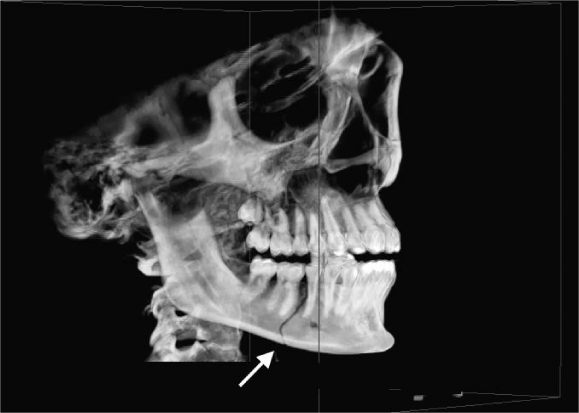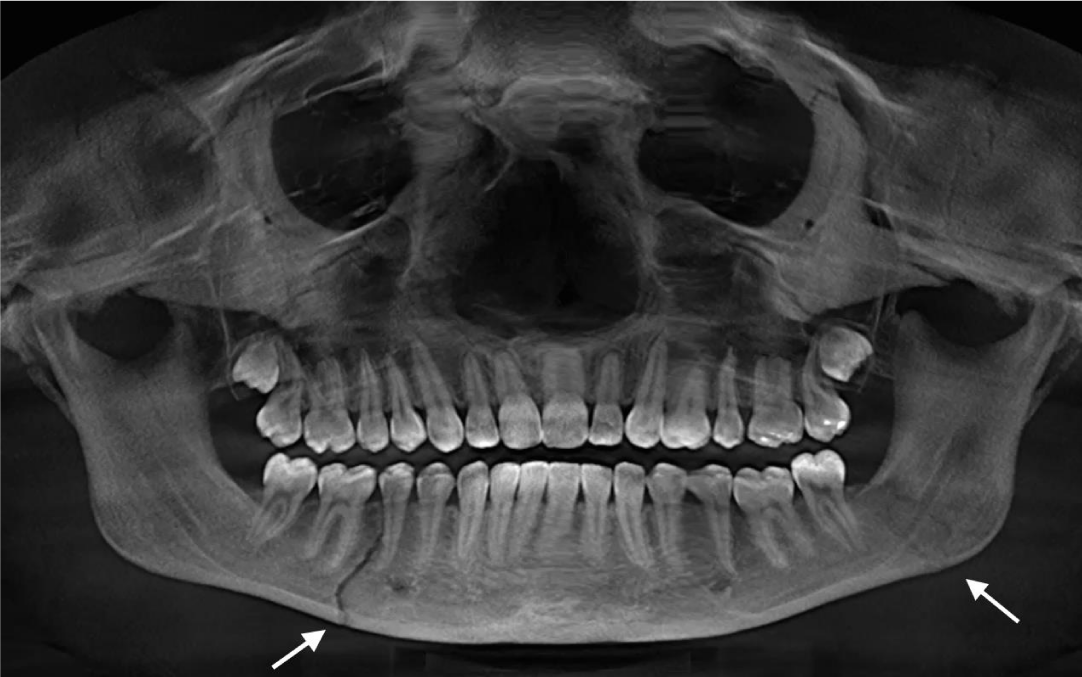An Unnecessary Broken Jaw: A Case Study Justifying Mandatory Protective Headgear for Girls’ and Women’s Lacrosse
Steven R. Murray1*, Coryann Ledford2, Duane O. Hartshorn3, Colby Crawford3, David Nock4, James A. Merrell3, Michael T. Reeder1, Robert W. Pettitt5, Jeremy R. Hawkins1
1Department of Kinesiology, Colorado Mesa University
2Department of Exercise and Nutritional Sciences, San Diego State University
3Colorado West Otolaryngologists, P.C., Grand Junction, Colorado
4Nock Oral Surgery, Grand Junction, Colorado
5Department of Academic Affairs, Rocky Mountain University of Health Professions, Provo, Utah
*Address for Correspondence: Steven Ross Murray, Department of Kinesiology, Colorado Mesa University, 1100 North Avenue, Grand Junction, CO 81501-3122, USA, Tel: +1-970-248-1158; E-mail: smurray@coloradomesa.edu
Submitted: 02 August 2017; Approved: 09 September 2017; Published: 13 September 2017
Citation this article: Murray SR, Ledford C, Hartshorn DO, Crawford C, Nock D, et al. An Unnecessary Broken Jaw: A Case Study Justifying Mandatory Protective Headgear for Girls’ and Women’s Lacrosse. Int J Sports Sci Med. 2017;1(2): 031-033.
Copyright: © 2017 Murray SR, et al. This is an open access article distributed under the Creative Commons Attribution License, which permits unrestricted use, distribution, and reproduction in any medium, provided the original work is properly cited
Download Fulltext PDF
Purpose: To demonstrate the inadequate safety equipment currently used in girls’ and women’s lacrosse by presenting a case of a female collegiate lacrosse player who suffered a mandibular fracture upon being struck by a lacrosse ball.
Methods: Physical examination, computerized tomography, and panoramic radiography were used to determine a definitive diagnosis of a mandibular fracture for a female collegiate lacrosse player presenting with acute pain after being struck on the jaw by a lacrosse ball.
Results: Computerized tomography and panoramic radiography revealed a fractured mandible.
Conclusion: This case highlights the need for mandatory protective headgear for female lacrosse players.
Introduction
The prevention of injuries is an important concern in sport. One of the fastest-growing sports in North America is girls’ and women’s lacrosse, and injuries, especially for those occurring to the neck, head, and face, are prevalent and potentially seriously debilitating [1-4]. The prevalence of head-and-neck injuries in women’s lacrosse is roughly 22% of all game-related and 12% of all practice-related injuries, respectively [5]. Further, although girls’ and women’s lacrosse is considered a “non-contact” sport, serious injuries can, and do, occur [2,4] and the lack of mandatory protective equipment is viewed as a precipitating factor [4]. Injury-surveillance data indicate that collegiate female lacrosse players, in comparison to their male counterparts, have higher rates of head-and-neck injuries [2]; these higher rates of injury led to a call that “the use of protective head/face gear should be encouraged [2, p. 537].” Unfortunately, that call was unheard for the last 15 years or so, and mandatory protective equipment in the girls’ and women’s game essentially was limited to eyewear and mouthpieces.
We present the case of a female collegiate lacrosse player who suffered a mandibular fracture upon being struck by a lacrosse ball. After surgical fixation, the athlete returned to play, fortunately with no further complications. The case illustrates the need for protective headgear in girls’ and women’s lacrosse.
Case Study
An 18-year-old female collegiate lacrosse player (157.5 cm [62 in.], 55 kg [121 lbs]) was hit on the left side of her jaw by a lacrosse ball in practice. She immediately was evaluated by the certified athletic trainer and then taken to the emergency department of the local hospital. On presentation, she exhibited a malocclusion and some bleeding in her oral cavity. She had no history of facial or cranial bone trauma, but had been fitted previously with braces for tooth alignment. Computerized Tomography (CT) revealed a bilaterally fractured mandible (Figure 1), and a panoramic radiograph indicated a fracture on the right side, between her premolars and molars (the body of the mandible), and on the left side, posteriorly, to her molars (the angle of the mandible) (Figure 2). The athlete was taken to surgery for a closed reduction of a mandibular fracture, with arch bars and maxillomandibular fixation. The patient was seen two weeks post-operative, where her maxillomandibular wires were removed; her arch bars were removed two weeks later. Throughout her recovery her teeth remained aligned properly, and she was able to maintain her body weight while on a soft-food diet for the first six weeks of the recovery period. At eight weeks post-operative, she was cleared to return to physical activities, with no restrictions.
Discussion
We present a case of a female collegiate lacrosse player who suffered a fractured mandible from being struck with a lacrosse ball during practice. To our knowledge, this is the first case of its type that has been reported in the literature, and it highlights the need for girls and women to wear protective headgear while participating in lacrosse. Lacrosse is a team sport, where two, 12-player teams face off, using pocketed sticks, or crosses, to pass, to catch, and to shoot a hard rubber ball into a net to score goals. Once a recreational sport of the native peoples of North America, lacrosse today is one of the fastest-growing sports in the United States and is played recreationally, interscholastically, intercollegiately, and professionally [1-3]. Both male and female athletes play lacrosse, but not coeducationally. The boys’ and men’s game allows for full-body contact, and protective equipment (e.g., helmet, shoulder pads) is required. The girls’ and women’s game is markedly different because deliberate, body-to-body contact is prohibited. As such, protective equipment, except for the goalkeepers, historically has not been part of the girls’ and women’s game, and in fact, has been prohibited [4]. The issue of mandatory equipment in girls’ and women’s lacrosse is contentious, however, with some believing that requiring helmets would result in “aggressive play” and allow a player to use the helmet as a weapon, while others believe that mandating protective equipment for preventing head injuries is long overdue [4]. Irrespective of one’s philosophical stance, research “indicate[s] that relying on [lacrosse] players’ behavior, rather than protective equipment, is not effective in safeguarding players from potentially serious or disfiguring head and facial injuries [5, p. 268].” The argument for prohibiting field players in lacrosse from wearing helmets is that the helmet could be used as a weapon against a non-helmeted player; however, injury data show this to be a specious argument. In the instances where helmets were optional, no injuries have been reported from a non-protected player being hurt by the helmet or facemask of a protected player [6]. The protective nature of a helmet and facemask can safeguard the wearer from impact injuries. Male lacrosse players have been clocked shooting lacrosse balls at speeds up to 114 mph [~183 km/h], with typical speeds in a game of 80 to 100 mph [~130 to160 km/h] being commonplace [7], and it is one of the reasons why they are required to wear helmets. While those speeds may not be typical of the women’s game, female lacrosse players can generate shots fast enough to create sufficient force to cause serious injury, especially to a helmet-less player. Female lacrosse players have a higher incidence rate of facial fractures [8] and head-and-neck injuries [9] than male lacrosse players. Fifty-six percent of these injuries are attributed to contact with a stick, and 20 percent are because of contact with the ball [5]. The long-term ramifications of head-and-neck and facial injuries can be quite debilitating, so efforts to prevent them should be encouraged. As in our case, a lacrosse ball shot by a collegiate female player produced enough force to cause a fractured mandible. As such, it highlights the need for girls and women to wear protective helmets with facial protection while playing lacrosse and warrants the investigation of the proper protective features necessary for an effective helmet. As of January 1, 2017, in the USA, girls and women are required to wear eye protection, but the use of headgear is optional, and if used, must meet a specific performance standard [10]. The standard is more concerned with producing a “softer” helmet, for the unfounded fear that a helmet-less player may be injured by a “hard” helmet. Moreover, eye guards are required, fortunately, and some helmets feature integrated eye protection. While we support the rule to allow all female lacrosse players the option of wearing a helmet, we believe that a more robust helmet, with a full facemask, should be required to help prevent potential facial and cranial injuries. We believe that lacrosse, like hockey, should require players to wear protective equipment, irrespective of the style of play or the sex of the individual. The girls’ and women’s hockey game is “non-contact”; yet according to the rules of the International Ice Hockey Federation, female players have to “wear full face masks” [11].
Conclusion
While girls’ and women’s lacrosse is a non-contact sport, in light of our case and reviewing the literature and injury data, we believe that a more robust helmet for female lacrosse players is warranted because of the impact forces that being hit by a lacrosse ball or stick can produce. The helmet should cover the head and incorporate a facemask that protects the face from the forehead to the chin and can withstand being struck by a lacrosse ball at typical game speeds. The full, face-masked helmet should be mandatory equipment for all girls and women participating in lacrosse.
- Crisco JJ, Costa L, Rich R, Schwartz JB, Wilcox B. Surrogate head form accelerations associated with stick checks in girls’ lacrosse. J Appl Biomech. 2015; 31: 122-127. https://goo.gl/hL724n
- Diamond PT, Gale SD. Head injuries in men’s and women’s lacrosse: a 10 year analysis of the NEISS database. Brain Inj. 2001; 15: 537-544. https://goo.gl/45woDZ
- Reynolds BB, Patrie J, Henry EJ, Goodkin HP, Broshek DK, Wintermark M, et al. Quantifying head impacts in collegiate lacrosse. Am J Sports Med. 2016; 44: 2947-2956. https://goo.gl/3trp6w
- Vinger P. The Mechanisms and Prevention of Sports Eye Injuries. 2017. https://goo.gl/YnATMw
- Dick R, Lincoln AE, Agel J, Carter EA, Marshall SW, Hinton RY. Descriptive epidemiology of collegiate women’s lacrosse injuries: national collegiate athletic association injury surveillance system, 1988-1989 through 2003-3004. J Athl Train. 2007; 42: 262-269. https://goo.gl/6n3zqg
- Vinger P. Why women’s lacrosse players should wear helmets. Lacrosse Magazine. 1993; 17: 8-9.
- Lax World. How fast can a lacrosse ball travel? 2017. https://goo.gl/UCeqzw
- Vincent HK, Adziarski L A, Vincent KR. Review of lacrosse-related musculoskeletal injuries in high school and collegiate players. Sports Health. 2015; 7: 448-451. https://goo.gl/ZSY4DU
- Hinton RY, Lincoln AE, Almquist JL, Douoguih WA, Sharma KM. Epidemiology of lacrosse injuries in high school aged girls and boys: A 3 year prospective study. Am J Sport Med. 2005; 33: 1305-1314. https://goo.gl/spZAEn
- US Lacrosse. Women's Lacrosse Headgear FAQ. 2017. https://goo.gl/EJ8a4q
- International Ice Hockey Federation. Rules. 2017. https://goo.gl/yzBrMS



Sign up for Article Alerts